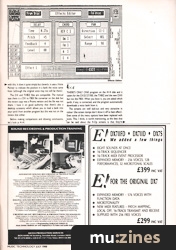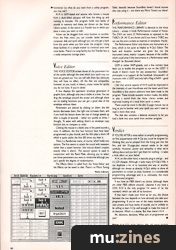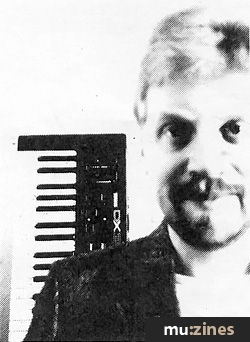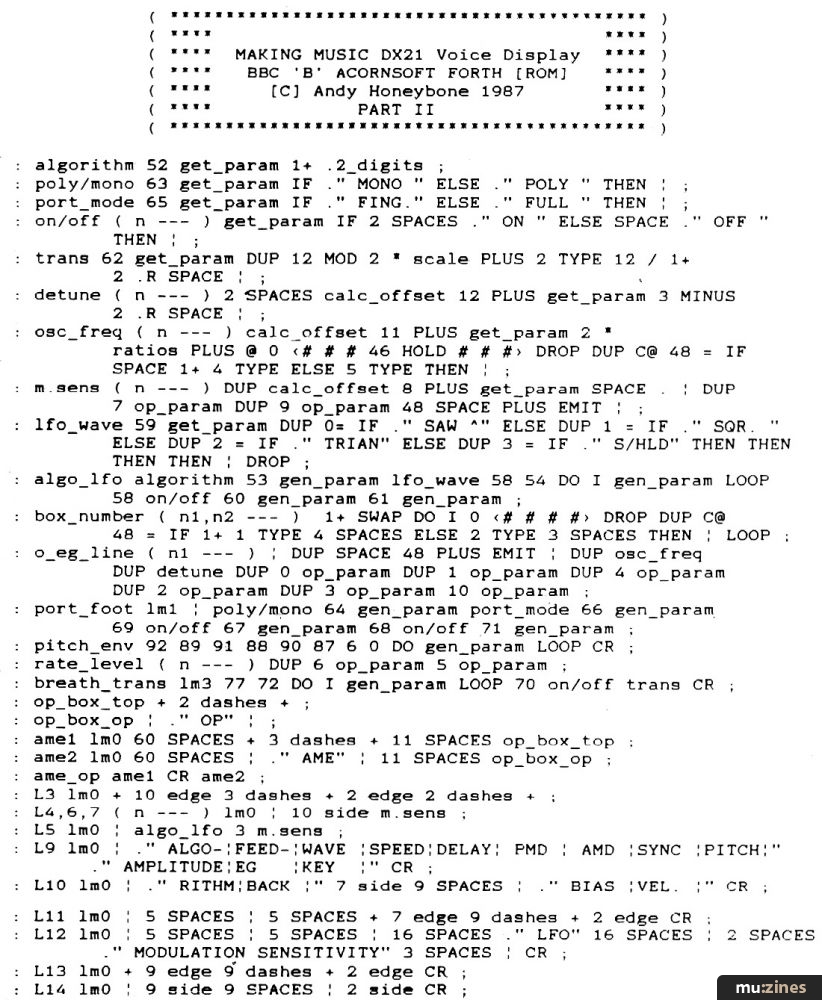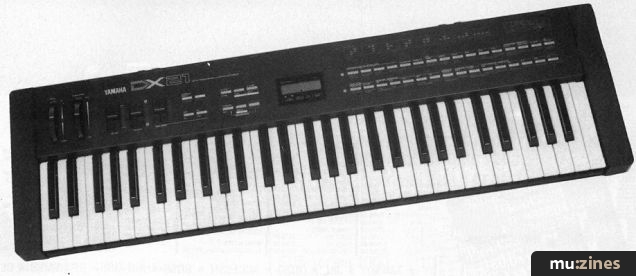Magazine Archive
Home -> Magazines -> Issues -> Articles in this issue -> View
FM 4-Operator Editors | |
Article from Music Technology, July 1988 | |
Two software packages that offer a generic approach to sound creation on Yamaha's four-operator FM synths. Ian Waugh boots up Dr T's 4-Op Deluxe and the Soundbits 4X4.
If the drudgery of FM programming has prevented you making a star of your FB01, DX11/21/27/100 or TX81Z, one of these four-operator FM voice editors could be for you.

TX81Z Voice Edit screen
THANK HEAVEN FOR digital synthesisers - praise the lord and pass the collection box. But they can be little buggers to program, can't they?
Anyone over the age of six will probably remember analogue synths. You knew where you were with those - the VCOs connected to the VCF, the VCFs connected to the VCA, and so on. With digital synthesisers, not only do you have to learn a whole new way of creating sounds, but you only get to see one parameter at a time - and that on an LCD the size of a matchbox. And to control all those parameters there are four buttons on the front of the synth which have to be pressed in a contortionistic series of devious combinations.
If this has never bothered you then you're probably a professional programmer. For the rest of us, however, there are Voice Editors. These can help in three ways: they can show on screen all (or most) of a sound's parameters enabling you to "see" what a sound looks like at a glance. They also let you arrange banks of sounds and save them to disk, far more convenient and reliable than storage on tape. Finally, they often have features not available from the synth itself such as Compare, Copy and Undo facilities, not to mention random voice generation.
And if you're still unconvinced - they're fun. Clicking parameters on screen may not be quite the same as sliding real sliders and twiddling real dials, but it sure beats the hell outta button pushin'.
The two programs under the hammer today allow you to edit a variety of Yamaha four-operator FM synths and expanders. 4-Op Deluxe is a Caged Artist/Dr Ts (distributed by MCM) production while 4X4 comes from Soundbits, one of the few British companies writing music software.
4-Op Deluxe
THERE ARE THREE separate programs on the 4-Op disc one for the DX21/27/100, one for the FB01 and one for the TX81Z. The DX program forms the core of the other two which have added facilities to accommodate the extra FB01 and TX81Z features.
The programs are not GEM-based but mouse-o-philes will be relieved to hear that virtually all functions can be controlled with the mouse. If you don't like mice you can still use the keyboard.
The main screens all contain three boxes: Voices (or Banks in the case of the FB01), Menu and Files. The Voices box lists a bank of voices. The programs can store several banks in memory and these are listed in the Files box; there are eight in the DX program, two for the FB01 and four for the TX81Z. Clicking on a new File shows that bank of voices.
From the Menu box you Save, Load, Get and Send banks and voices to and from disc and the synth. From here you access Store, Copy, Move and Swap operations. This is also your departure point for the Voice and Performance (Configuration in the case of the FB01) Editors, and these screens have their own Menu boxes too. The program isn't controlled through a series of nested menus, however, and most screens can take you to most other screens. It's a mite confusing at first but I soon found my way around.
The FB01 and TX81Z programs also have an Instruments box. In the case of the FB01 this is used to select the current instrument for editing. In the TX81Z program they show the instruments used by the currently selected Performance.
System Control
BEFORE WE GET delving into the Editors, let's make a brief sojourn to the Systems screen.
Here you can set parameters such as System Exclusive Channel (Yamaha synths have a MIDI channel as part of their SysEx messages) and altering this allows more than one instrument to be controlled by the program.
There are Merge options for incoming data and you can filter Program Change information and alter the colour scheme.

FB01 Main screen
In addition, the TX81Z program lets you alter the basic Receive and Transmit Channels; adjust Master Tune, Program Change, Control Change and Pitch Bend and so on and switch Memory Protect on or off.
To hear the current voice you press the right mouse button. This can play a single note or a glissando by moving the mouse left and right. The program can also accept input from a master keyboard or an external sequencer and play the music while you edit the sounds. Neat.
Some of these settings can be saved and the program will automatically load them when booted. You save to the system disk, however, which always makes me uneasy.
From the Systems menu you can program Effects, set up the Program Change Table and Micro Tuning options and all these can be saved as separate files, too.
The Editors
THE VOICE AND Performance (or Configuration) Editors each have three Buffers: Edit, Compare and Undo.
Both editors operate in exactly the same way so let's see how the Voice Editor works as this is common to all programs.
A voice selected for editing goes, naturally enough, into the Edit Buffer. Compare will compare it with any voice - the original one or any other - and highlights the parameters which are different. Copy allows you to select and copy any parameters from the Compare voice to the Edit voice.
The Undo Buffer stores the last-edited voice and Undo swaps this with the voice in the Edit Buffer.
Parameters are selected by clicking on them and altered with the Virtual Slider running up the left of the screen. It's a similar idea to the slider used by Steinberg in their Pro24 program (who was first, I wonder) to simulate the DX7's Data Entry slider. You don't have to zap off to the left of the screen for the slider, however, you can "pick it up" by moving to its vertical position. Alternatively you can use the + and - keys or type in a new value directly.
Voice Editor
AND SO TO the Voice Editor. At the top left of the screen is a box containing a graphic representation of all four operators' envelope generators. The currently selected operator's envelope is highlighted and can be dragged around the box with the mouse. The resolution can be scaled from 1ms to 32 seconds - a suitably large range to cater for most sounds, I reckon.
All a voice's numeric parameters are displayed on the bottom half of the screen and can be altered as described above. You can mute individual operators - ideal for seeing what effect an operator has on a sound.
Randomisation
HARDLY A VOICE Editor worthy of the name exists without some form of voice creation facility. 4-Op makes no attempt at intelligent voice creation. It allows you to select a group of parameters with a Rand Mask and then it randomises them by an amount ranging from 1 to 99%. The Rand Mask can be saved.
Undo will remove the effects of Randomisation so it's a simple matter to keep randomising a voice to see if anything better turns up.

Effects Editor
The Randomisation process is very interesting, although I wouldn't advise you to start a career as a professional programmer with it. It's particularly fascinating to start with an Initial Voice and see how far Randomisation can take it - you may produce a gem. During experiments, the process produced sounds varying in quality and usability from an African Hollow Log to someone taking a bath in mushy peas.
Performance Editor
THE PERFORMANCE (or Configuration) Bank is identical in operation to the Voice Bank - except it contains Performances.
The Performance Editor shows all the instruments and their associated parameters on screen at once. This is very useful indeed and makes the creation of Performances a pleasure. There's even a Randomise function here, would you believe, and you can create a Rand Mask for Performances, too.
Re-arranging a voice bank from which Performances have been arranged is asking for trouble and the astute among you may be wondering how the program copes with this. It does it quite simply but cleverly: it uses a Voice Pointer to indicate the position in a bank the voice came from (although the original voice may not still be there).
The DX and TX81Z files are compatible. The manual says there is a DX to FB01 file converter on the disk but the review copy was a Promo version and the file was not there. I have it on good authority that there's also a desktop accessory which allows you to load a bank into your synth from another program but this was not on the review disk either.
Before making comparisons and drawing conclusions, let's look at 4X4.
4X4
THERE'S ONLY ONE program on the 4X4 disk and it caters for the DX21/27/100, the TX81Z and the new DX11 but not the FB01. When you boot it, you are asked which synth, if any, is connected, and the program automatically downloads a voice bank from it. The screens are well laid-out and very attractive in colour (the screen dumps don't show it off to best effect). Even some of the menu options have been replaced with icons. This, I think, is worth mentioning, as the best that can be said about the 4-Op screens is that they're functional (so what do you want from a utility program, you may ask?).
4X4 is GEM-based and anyone who knows a mouse from a duck-billed platypus will have the thing up and running in minutes. The program holds two banks of sounds in memory and these are shown on the Voice Library screen. In the centre is a Transfer box in which you place a voice you want to edit.
Voices can be dragged from once location to another. From the Files menu you can transfer banks between computer, disk and synth although you can only get a bank from the synth when you first enter the program. Using these facilities it's a simple matter to construct your own voice banks. There's no swap facility but the Transfer box is a ready temporary storage place.
Voice Editor
THE VOICE EDITOR screen shows all the parameters for all the synths although the ones which your synth may not have are greyed out. You can still edit them but obviously they will have no effect. All the files are compatible, however, so you could, in theory, create voices for synths you do not have. If you're clever.
A box displays the operators' envelope generators in graphic form, although only one is visible at a time. You can drag the envelope around the screen and although there are no scaling functions you can get a good idea of the envelope without them.
Parameters are altered by clicking on them: the left button decreases them, the right one increases them, and if you hold the button down the rate of change speeds up after a couple of seconds - rather too quickly at times, I thought. To assist with editing there's an envelope copy function but no compare or undo.
Clicking the mouse in a blank area of the panel sounds note. In addition, the first four function keys have been programmed to play chords, and the fifth plays a short riff which is quite catchy the first 100 times you hear it.

Voice Library
There is a Randomise menu, of course, which holds two options. The first seems to attack the sound with tweezers rather than a steam hammer (the manual doesn't explain exactly what it alters). The second option is used in conjunction with the Rand Mask, allowing you to select just those parameters you want to randomise although you can't specify the degree of randomisation.
The Effects Editor is called from the Voice Editor and the Effects can be saved to disk. There's no Micro Tuning Table, basically because Soundbits haven't found anyone who was using it - are there any Micro Tuners out there?
Performance Editor
THE PERFORMANCE LIBRARY is identical to the Voice Library - except it holds Performances instead of Voices. The DX11 can store 32 Performances as opposed to the TX81Z's 24. All 32 are shown and if you have a TX81Z you can use the extra sockets as reserves or templates. Handy.
The Performance Editor only shows one instrument at a time, which is not quite as helpful as 4-Op's Editor. The bank and location number are given but not the instrument name, mainly I suspect, because of the conflict which could arise if the instruments in a Performance were changed (as discussed above).
GEM is rather RAM-greedy, and a few comers have been cut to enable the program to run on the 520ST (I doubt if there's room for any accessories). Soundbits' philosophy is to support all the hundreds (thousands?) of musicians with a 520ST and only half a Meg of RAM - good on them.
I felt that several aspects of 4X4 could be improved in the interests of user-friendliness and the latest word from Soundbits is that several additions have been made to the program. These include saveable random masks, the ability to play a sound from the Voice Library screen and improved loading of a voice from synth to editor.
There could be more in the slim 12-page manual, but as long as you're familiar with your synth you won't need to read it more than once.
The disk also contains a desktop accessory to let you load a bank into your synth from another program.
Verdict
IF YOU'RE AFTER a voice editor to simplify programming, on first acquaintance with 4-Op you could be forgiven for thinking that you've jumped from the frying pan into the fire, and the 50-page-plus manual needs to be read carefully. However, power and versatility is what we're talking about and you don't get them for nothing - it takes a little effort on your behalf.
4X4, on the other hand, is basically plug-in and go - and it's £24 cheaper. Although it lacks many of 4-Op's frills, it can duplicate a lot of its functions one way or another although not always as directly. 4-Op's ability to show all parameters on screen at once, however, is a considerable programming advantage and it is, ultimately, the more sophisticated program.
If you have an FB01 there's no choice (although there are other FB01 editors around). Likewise if you have a DX11, 4X4 is the only program I'm aware of (at the moment) which can edit all its functions.
If that hasn't made your mind up for you, the choice between the two depends on how seriously you take your programming. If you're one of the many musicians who uses presets and buys banks of sounds, you're unlikely to be willing to learn 4-Op well enough to make the most of its features. Which is a shame. But then there's 4X4...
Ah, decisions, decisions. What sort of programmer are you?
Prices 4X4 £75; 4-Op Deluxe £99. All prices include VAT
(Contact Details)
Featuring related gear
21 Today
(EMM Aug 85)
21 Today - Yamaha DX21 synthesiser
(ES Sep 85)
June Calendar
(MM Jun 86)
Moving On - Yamaha DX21
(SOS Jan 86)
Technically Speaking (Part 3)
(MM Jun 86)
Technically Speaking
(MM Nov 86)
Technically Speaking
(MM Apr 87)
Technically Speaking
(MM Sep 87)
Technically Speaking
(MM Oct 87)
The Dynamic Duo
(SOS Feb 86)
Yamaha DX100 - SynthCheck
(IM Feb 86)
Yamaha DX100
(12T Mar 86)
Yamaha DX11 synthesizer
(SOS Jun 88)
Yamaha DX21 - Synthcheck
(IM Sep 85)
Yamaha DX21 Synth
(12T Aug 85)
Yamaha FB-01
(SOS Oct 86)
Yamaha FB01 - FM Sound Generator
(MT Nov 86)
Yamaha FB01 - ExpanderCheck
(IM Dec 86)
Patchwork
(EMM Apr 86)
Patchwork
(EMM Jun 86)
Patchwork
(EMM Oct 86)
Patchwork
(MT Feb 87)
Patchwork
(MT Mar 87)
Patchwork
(MT Sep 87)
Patchwork
(MT Feb 88)
Patchwork
(MT Mar 88)
Patchwork
(MT Jun 88)
Patchwork
(MT Jul 88)
Patchwork
(MT Sep 88)
Patchwork
(MT Oct 88)
Patchwork
(MT Mar 89)
Patchwork
(MT Jun 89)
Patchwork
(MT Sep 89)

Patchwork
(MT Oct 90)
...and 15 more Patchwork articles... (Show these)
Browse category: Synthesizer > Yamaha
Browse category: Synthesizer Module > Yamaha
Publisher: Music Technology - Music Maker Publications (UK), Future Publishing.
The current copyright owner/s of this content may differ from the originally published copyright notice.
More details on copyright ownership...
Gear in this article:
Software: Editor/Librarian > Dr. T > 4-OP Deluxe
Software: Editor/Librarian > Soundbits > 4X4
Gear Tags:
Review by Ian Waugh
Previous article in this issue:
Help Support The Things You Love
mu:zines is the result of thousands of hours of effort, and will require many thousands more going forward to reach our goals of getting all this content online.
If you value this resource, you can support this project - it really helps!
Donations for April 2024
Issues donated this month: 0
New issues that have been donated or scanned for us this month.
Funds donated this month: £7.00
All donations and support are gratefully appreciated - thank you.
Magazines Needed - Can You Help?
Do you have any of these magazine issues?
If so, and you can donate, lend or scan them to help complete our archive, please get in touch via the Contribute page - thanks!


